Evolution of Shock Waves during Muzzle Jet Impinging Moving Bodies under Different Constrained Boundaries
Abstract
:1. Introduction
2. Physical and Mesh Models
2.1. Physical Model
2.2. Dynamic Mesh Method
2.3. Mesh Model
2.4. Boundary Conditions and Solution Methods
2.5. Mesh Independence Verification
3. Analysis of Test Results
3.1. Test Equipment
3.2. Test Plan
3.3. Test Results
4. Results of Numerical Simulations
4.1. Muzzle Jet
4.2. Evolution of Shock Waves and Vortices
4.3. Comparison of Pressure
4.4. Key Parameters of Moving Bodies
5. Conclusions
- (1)
- The shock wave of the spherical muzzle, which should have been circumferentially symmetrical, was distorted due to the presence of the constrained track, and the entire structure was inclined to the area above the muzzle. Because the shock wave was blocked by the track, transverse air flow was generated, which led to the formation of vortices. The characteristics of the evolution of the vortices were unique and thus different from those of the traditional model of the muzzle jet.
- (2)
- Because the test platform was close to the ground, the shock wave of the muzzle was reflected from it, which enriched the characteristics of the evolution of the shock wave and the vortex in the asymmetric muzzle jet. This led to the formation of a Mach rod and a vortex in the area above the ground in Case 1. However, in Case 2, the shock wave was reflected multiple times between the ground and the constrained rail without forming a stable low-pressure area or a vortex.
- (3)
- The constrained track influenced the development and evolution of the muzzle jet, where this was directly reflected by the difference in pressure and the velocity of the shock at the monitoring points between the cases considered. At the same time, the Mach number and total thrust of the moving body in Case 2 were higher than those in Case 1.
Author Contributions
Funding
Data Availability Statement
Acknowledgments
Conflicts of Interest
References
- Goto, K.; Kato, Y.; Ishihara, K.; Matsuoka, K.; Kasahara, J.; Matsuo, A.; Funaki, I.; Nakata, D.; Higashino, K.; Tanatsugu, N. Thrust validation of rotating detonation engine system by moving rocket track test. J. Propuls. Power 2020, 37, 419–425. [Google Scholar] [CrossRef]
- Zhao, P.G.; Liu, Z.; Dang, T.J.; Sun, Y.; Sun, Y. Numerical and wind tunnel test research on aerodynamic characteristics of high-speed rocket sled under the influence of ground effect. Chin. J. Comput. Mech. 2023, 40, 314–322. [Google Scholar] [CrossRef]
- Jiang, S.Y.; Wang, H.; Lin, C.J.; Wang, J.L. Establishment and simulation of two-dimensional interior ballistics model of large caliber Davis gun considering the axial movement of tubular charge clusters. Acta Armamentarii 2016, 37, 1941–1948. [Google Scholar] [CrossRef]
- Wang, G.; Cheng, C.; Zhang, X.; Huang, X. Numerical simulation and analysis of muzzle flow during a rarefaction wave gun firing. Propellants Explos. Pyrotech. 2021, 46, 1902–1913. [Google Scholar] [CrossRef]
- Chaturvedi, E.; Dwivedi, R.K. Computer aided design and analysis of a tunable muzzle brake. Def. Technol. 2019, 15, 89–94. [Google Scholar] [CrossRef]
- Zhao, X.Y.; Zhou, K.D.; He, L.; Lu, Y.; Wang, J.; Zheng, Q. Numerical simulation and experiment on impulse noise in a small caliber rifle with muzzle brake. Shock Vib. 2019, 2019, 5938034. [Google Scholar] [CrossRef]
- Debnath, P.; Pandey, K.M. Numerical Investigation on detonation combustion waves of hydrogen-air mixture in pulse detonation combustor with block-age. Adv. Aircr. Spacecr. Sci. 2023, 10, 203–222. [Google Scholar]
- Jones, A.R.; Medina, A.; Spooner, H.; Mulleners, K. Characterizing a burst leading-edge vortex on a rotating flat plate wing. Exp. Fluids 2016, 57, 52. [Google Scholar] [CrossRef]
- Moumen, A.; Grossen, J.; Ndindabahizi, I.; Gallant, J.; Hendrick, P. Visualization and analysis of muzzle flow fields using the background-oriented schlieren technique. J. Vis. 2020, 23, 409–423. [Google Scholar] [CrossRef]
- Li, Z.J.; Wang, H. Effect of Precursor Flow Field of Muzzle on the Combustion Gas Jet Flow of Gun Propellant. Chin. J. Energetic Mater. 2017, 25, 282–290. [Google Scholar] [CrossRef]
- Mizukaki, T. Visualization and force measurement of high-temperature, supersonic impulse jet impinging on baffle plate. J. Vis. 2007, 10, 227–235. [Google Scholar] [CrossRef]
- Bin, J.; Kim, M.; Lee, S. A numerical study on the generation of impulsive noise by complex flows discharging from a muzzle. Int. J. Numer. Methods Eng. 2010, 75, 964–991. [Google Scholar] [CrossRef]
- Florio, L.A. Effect of vent opening area and arrangement on gas flow field as gas propelled cylinder exits a flow tube. Meccanica 2010, 45, 475–501. [Google Scholar] [CrossRef]
- Schmidt, E.M.; Shear, D. Optical measurements of muzzle blast. AIAA J. 2012, 13, 1086–1091. [Google Scholar] [CrossRef]
- Zeqing, G.; Xiaohai, J.; Yang, W. Parallel numerical simulation of muzzle reacting flow. Chin. J. Comput. Mech. 2013, 30, 111–116+123. [Google Scholar] [CrossRef]
- Zeqing, G.; Haitao, Q.; Xiaohai, J. Numerical simulation on the characteristics of flow field of the muzzle of embedded aircraft gun. Acta Armamentarii 2017, 38, 2373–2378. [Google Scholar] [CrossRef]
- Zhang, H.; Chen, Z.; Guo, Z.; Zheng, C.; Xue, D. Numerical investigation on the three-dimensional flow characteristics of unsteady subsonic elliptic jet. Comput. Fluids 2018, 160, 78–92. [Google Scholar] [CrossRef]
- Zhang, H.; Xiao, Y.; Chuan, Z. Characteristics of three-dimensional flow field structure of supersonic transverse jet. J. Propuls. Technol. 2023, 44, 30–39. [Google Scholar] [CrossRef]
- Du, P.; Lu, J.; Feng, J.; Li, X. Numerical Simulation and Analysis of Flow Field during Dynamic Launching of Electromagnetic Rail Launcher Based on Overlap-ping Multi-block Structured Mesh. Acta Armamentarii 2018, 39, 234–244. [Google Scholar] [CrossRef]
- Zhou, P.; Cao, C.; Dong, H. Analysis of Interior Ballistic Characteristics and Muzzle Flow Field of High-pressure Gas Launcher. Acta Armamentarii 2016, 37, 1612–1616. [Google Scholar] [CrossRef]
- Li, Z.; Wang, H.; Chen, J. Ground effects on the hypervelocity jet flow and the stability of projectile. Eng. Appl. Comput. Fluid Mech. 2018, 12, 375–384. [Google Scholar] [CrossRef]


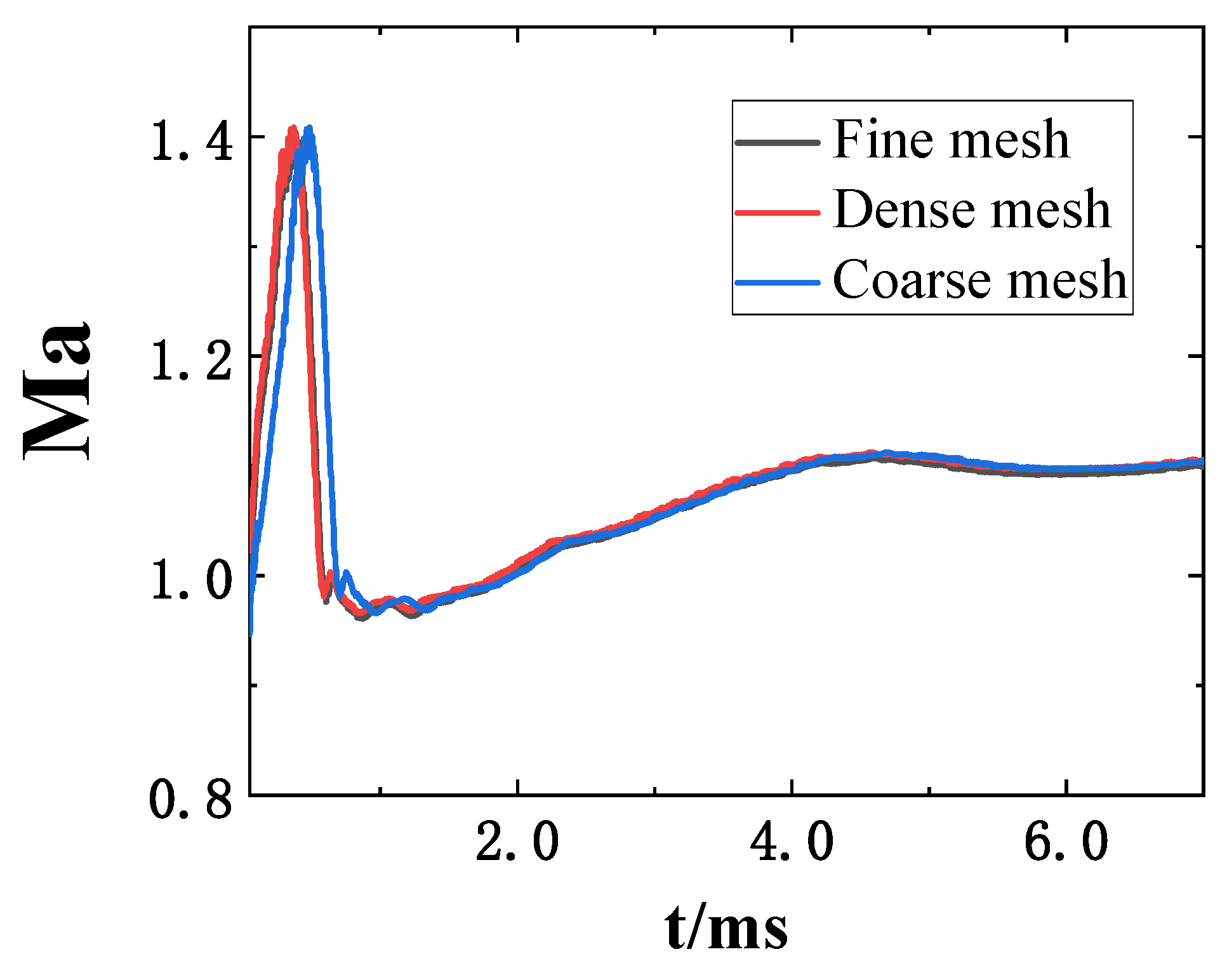
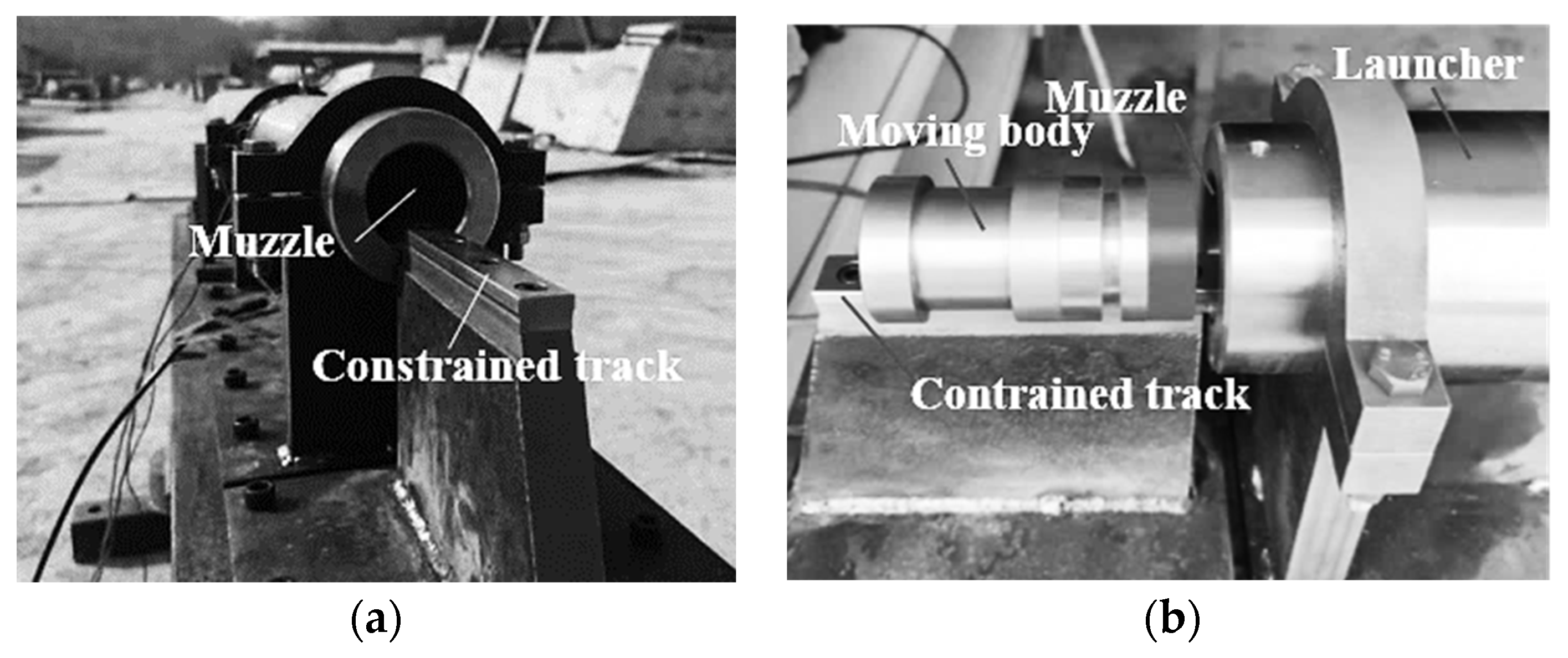
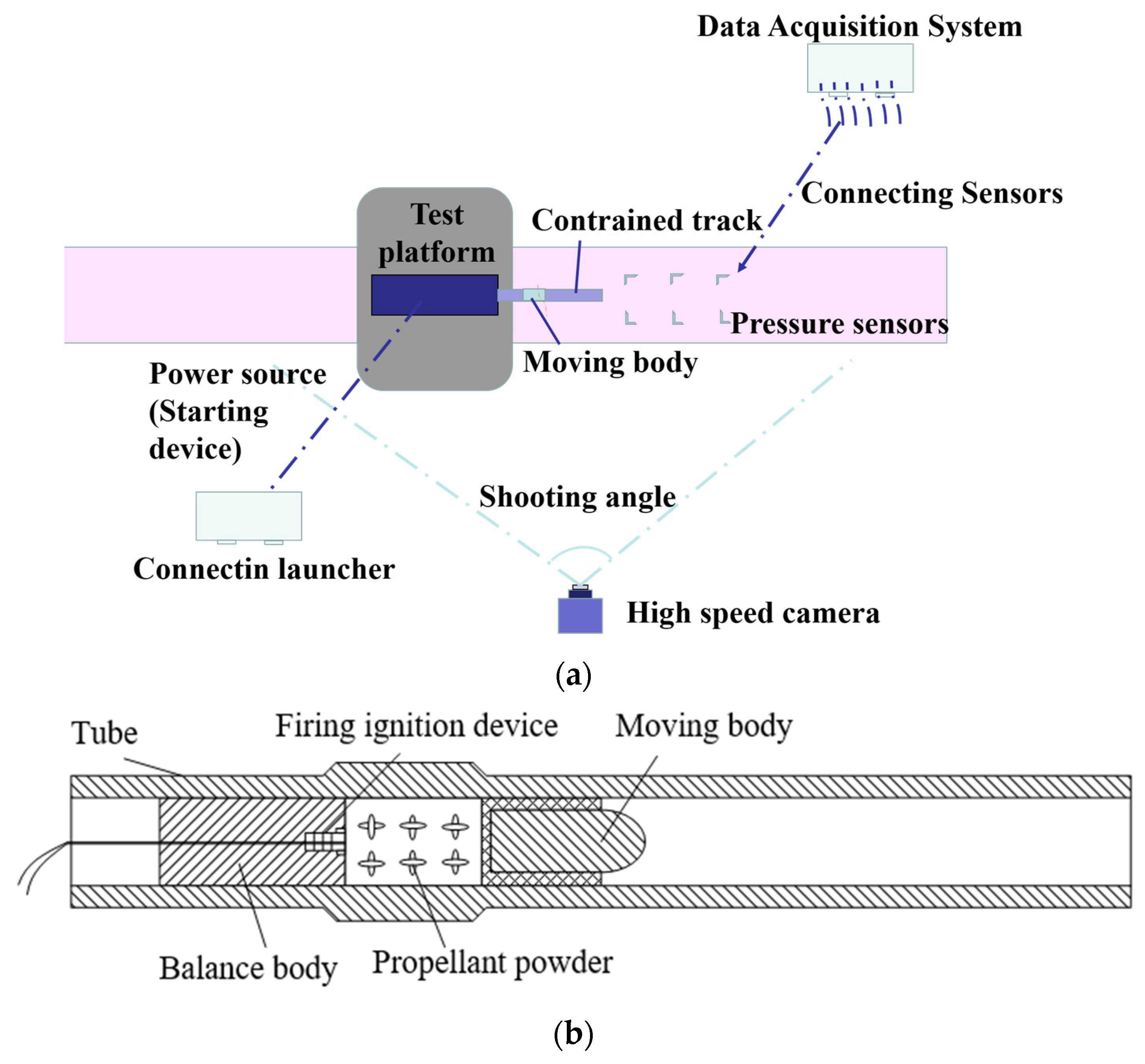

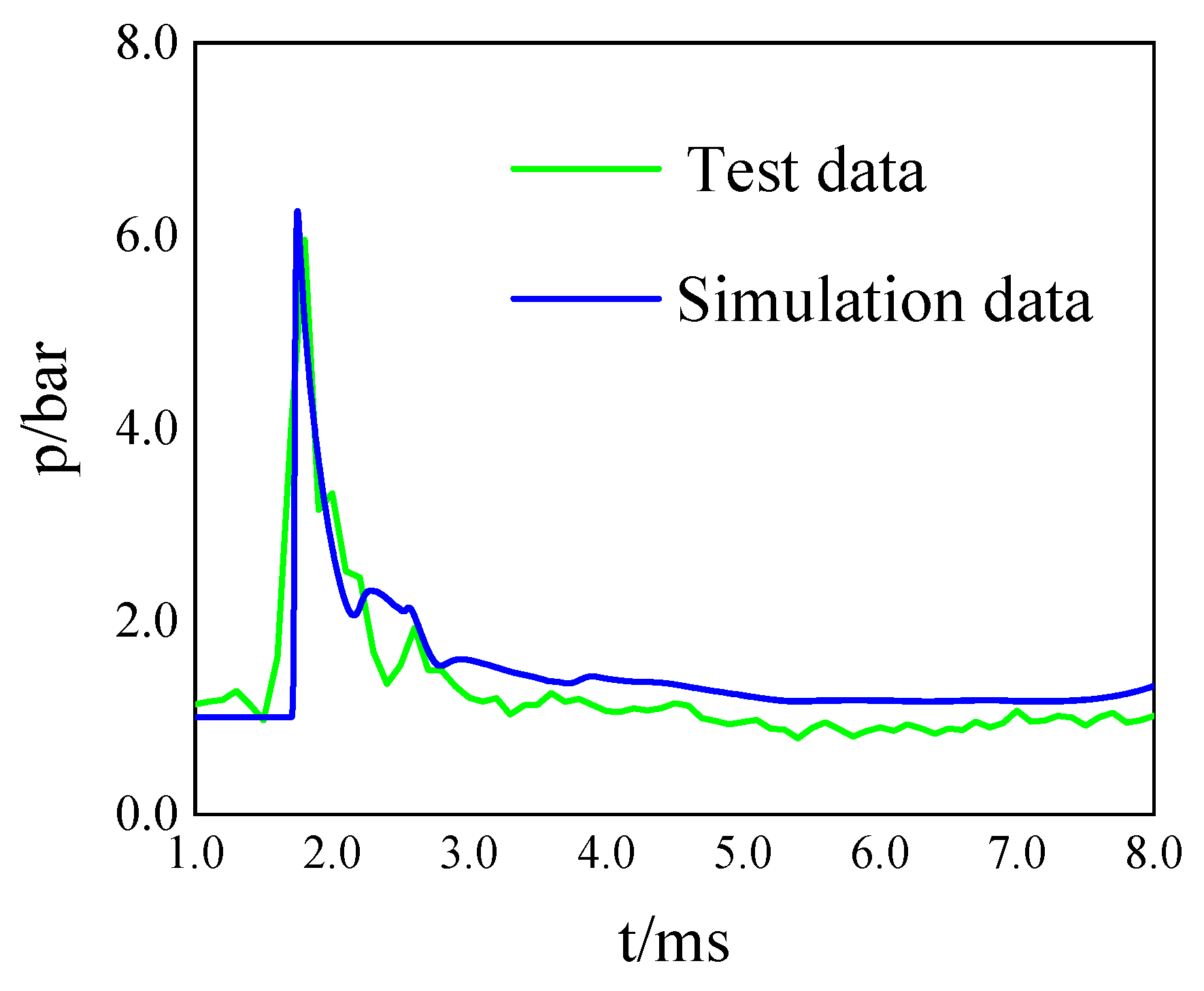




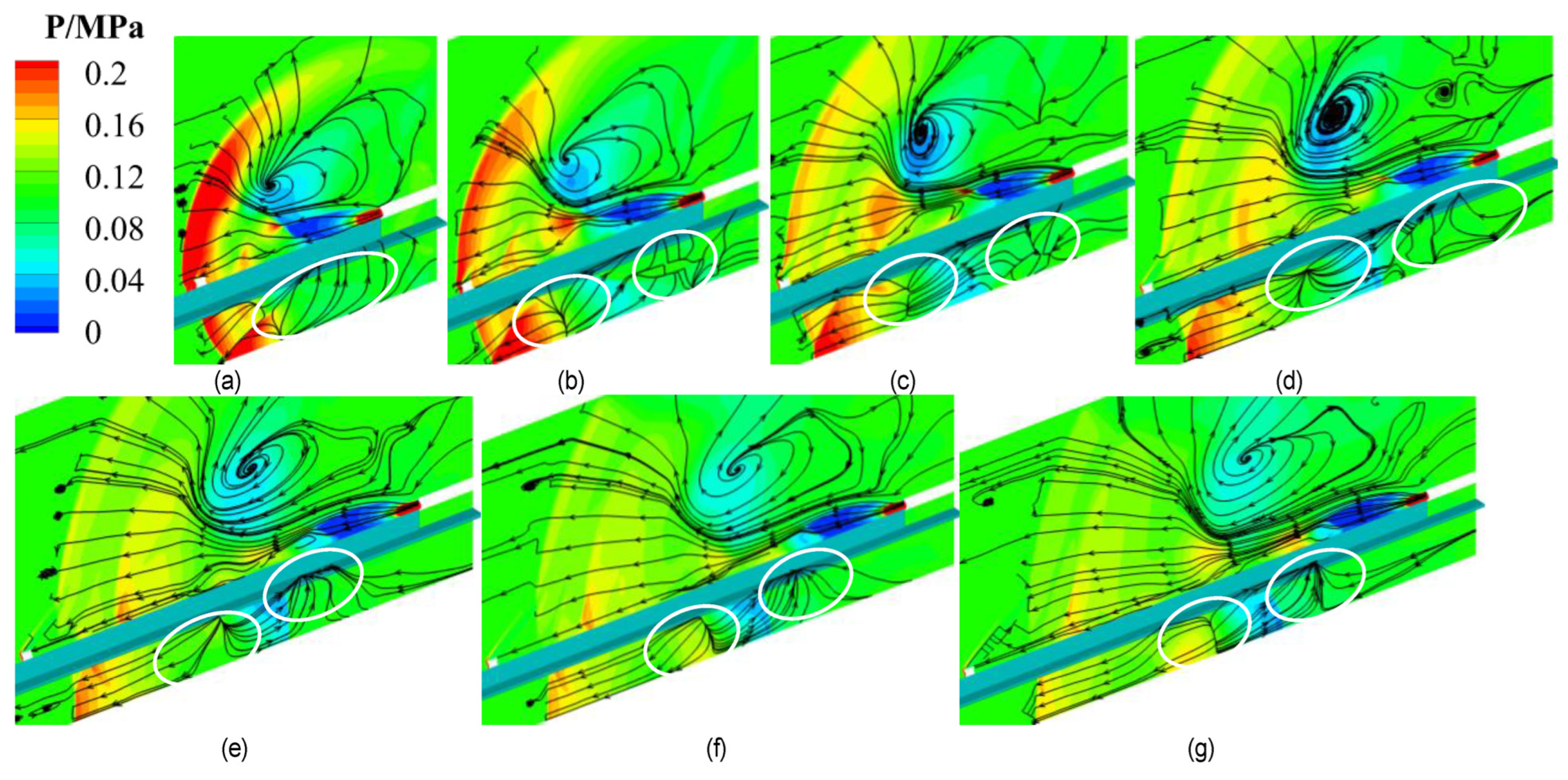
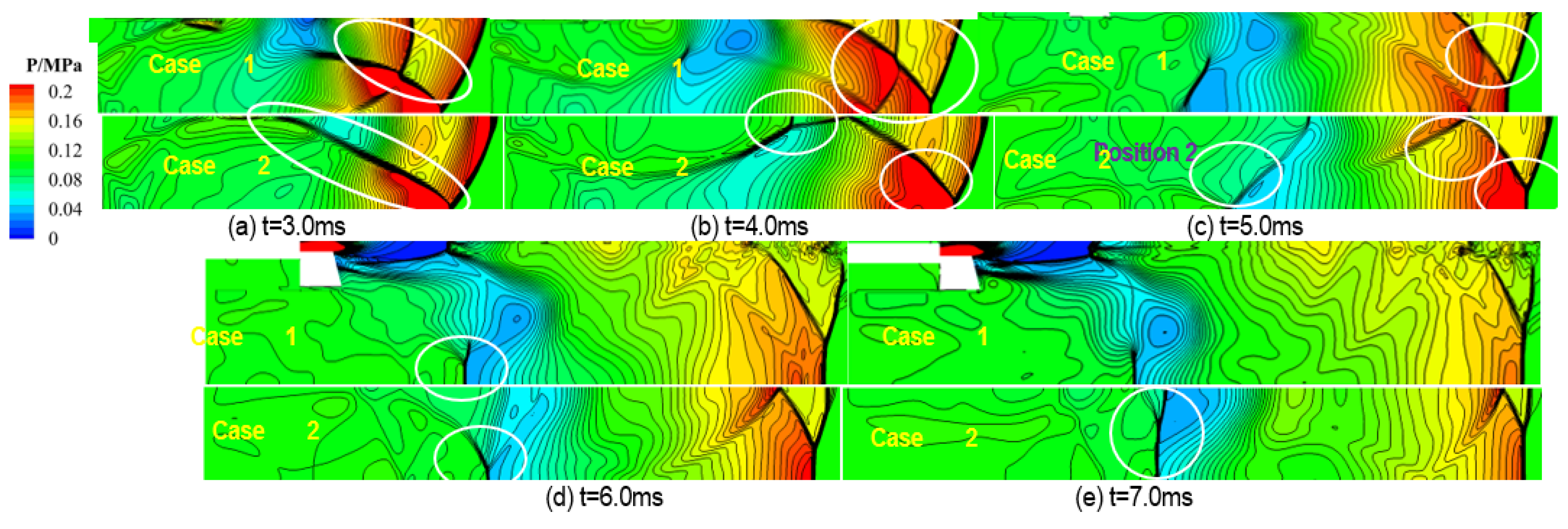


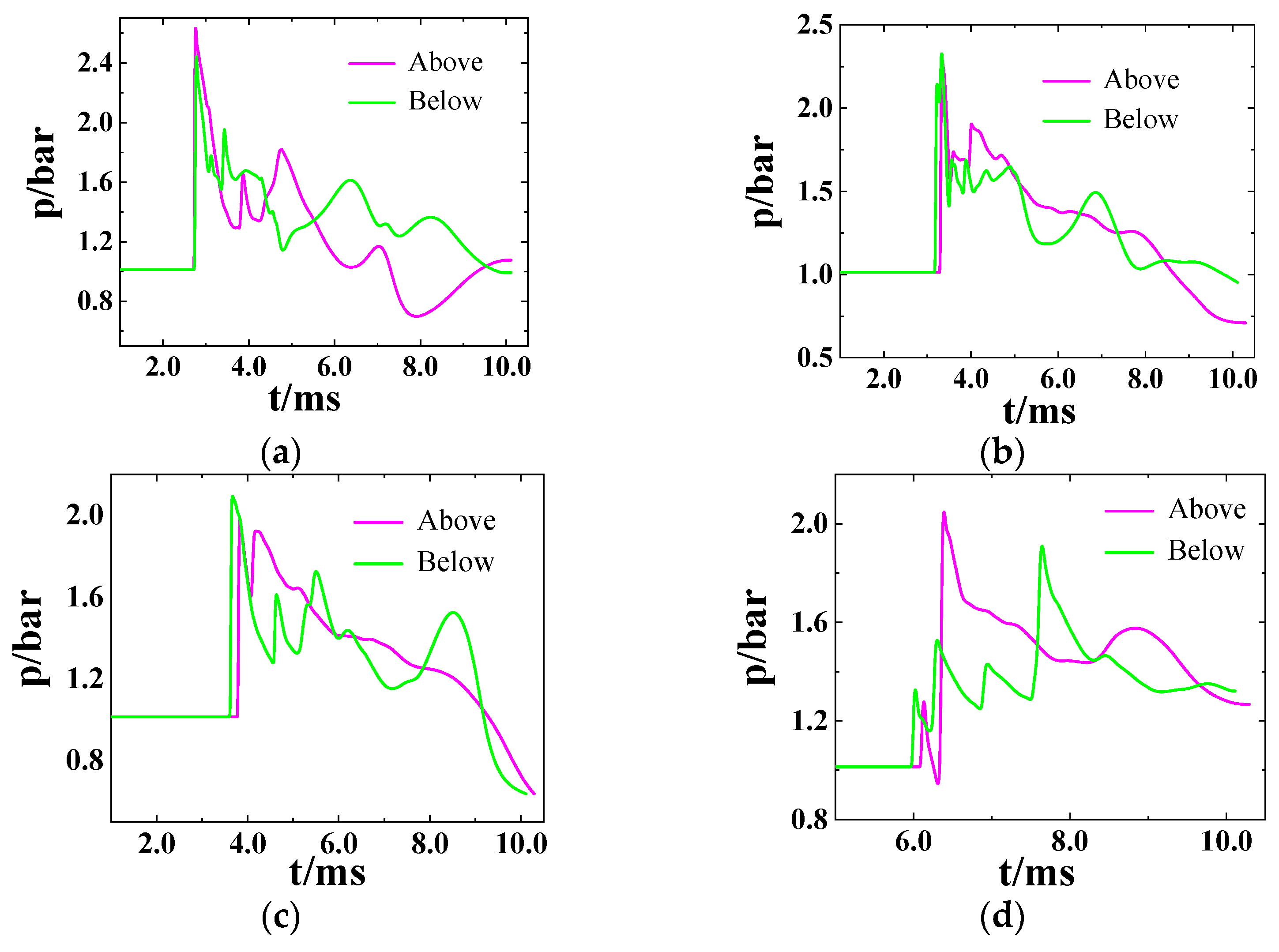
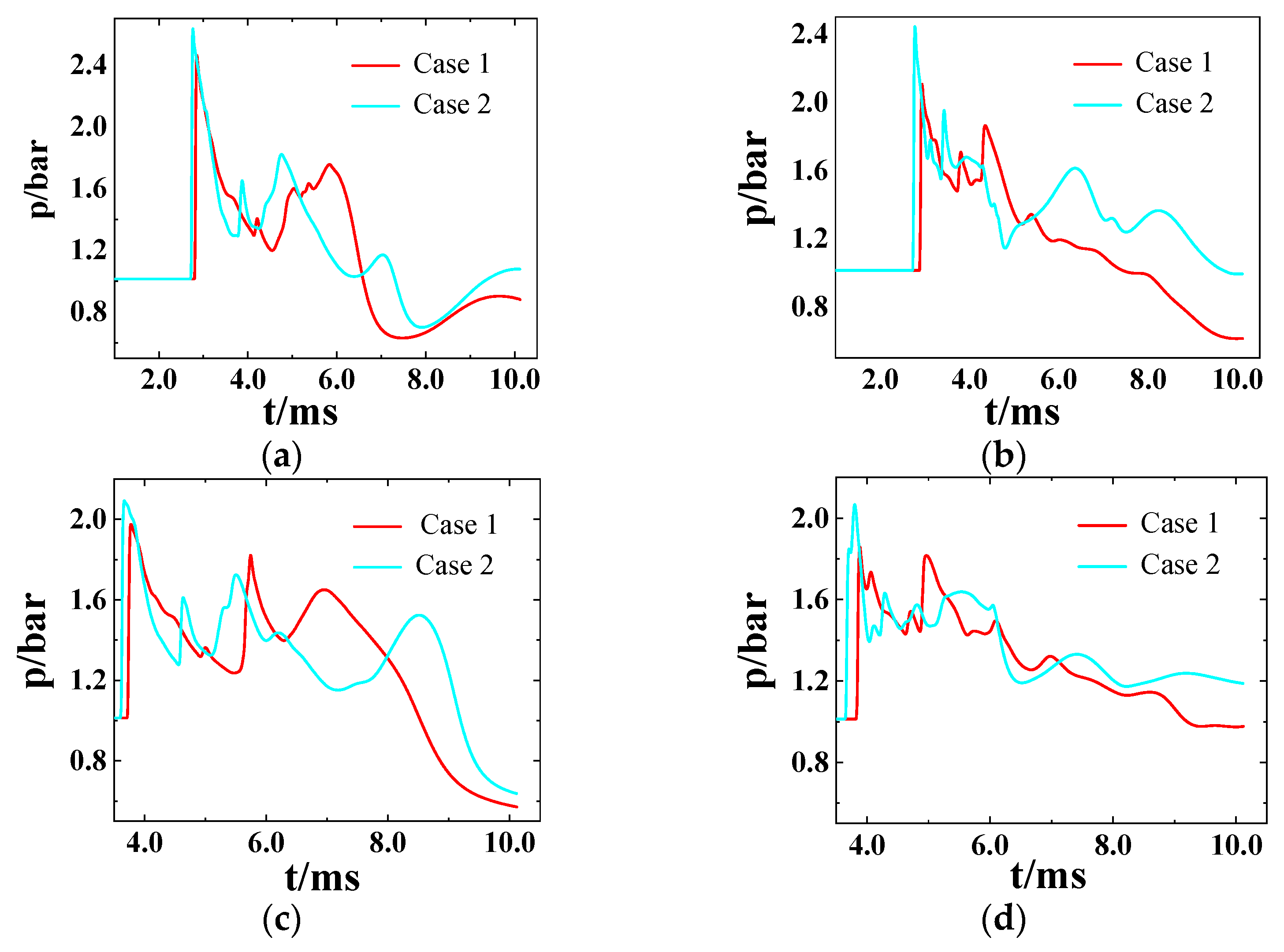

| Point | Location (x, y, z)/mm |
|---|---|
| A-above A-below | (1600, 60, 200) (1600, 60, −200) |
| B-above B-below | (1800, 35, 100) (1800, 35, −100) |
| C-above C-below | (2000, 60, 200) (2000, 60, −200) |
| D-above D-below | (3000, 0, 200) (3000, 0, −200) |
Disclaimer/Publisher’s Note: The statements, opinions and data contained in all publications are solely those of the individual author(s) and contributor(s) and not of MDPI and/or the editor(s). MDPI and/or the editor(s) disclaim responsibility for any injury to people or property resulting from any ideas, methods, instructions or products referred to in the content. |
© 2023 by the authors. Licensee MDPI, Basel, Switzerland. This article is an open access article distributed under the terms and conditions of the Creative Commons Attribution (CC BY) license (https://creativecommons.org/licenses/by/4.0/).
Share and Cite
Li, Z.; Wang, H. Evolution of Shock Waves during Muzzle Jet Impinging Moving Bodies under Different Constrained Boundaries. Aerospace 2023, 10, 908. https://doi.org/10.3390/aerospace10110908
Li Z, Wang H. Evolution of Shock Waves during Muzzle Jet Impinging Moving Bodies under Different Constrained Boundaries. Aerospace. 2023; 10(11):908. https://doi.org/10.3390/aerospace10110908
Chicago/Turabian StyleLi, Zijie, and Hao Wang. 2023. "Evolution of Shock Waves during Muzzle Jet Impinging Moving Bodies under Different Constrained Boundaries" Aerospace 10, no. 11: 908. https://doi.org/10.3390/aerospace10110908
APA StyleLi, Z., & Wang, H. (2023). Evolution of Shock Waves during Muzzle Jet Impinging Moving Bodies under Different Constrained Boundaries. Aerospace, 10(11), 908. https://doi.org/10.3390/aerospace10110908





